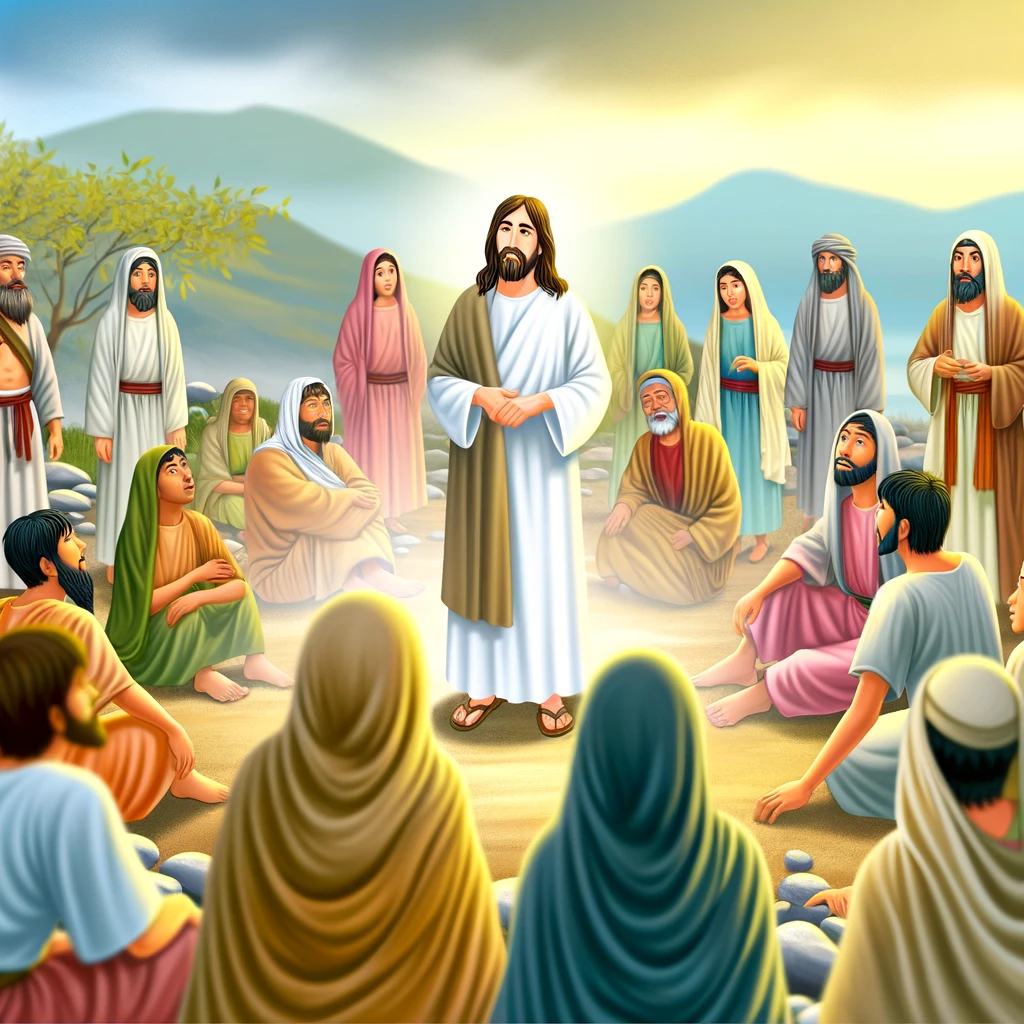
In the 1st century CE, the Roman Empire’s vast and diverse cultural landscape provided a backdrop for a range of social norms and religious practices. Within this setting, Judea stood out, marked by its own traditions and the Jewish faith’s deep historical roots. It was into this world that Jesus of Nazareth was born, bringing teachings that would profoundly challenge the status quo.
Jesus’ ministry, as depicted in the Christian Gospels, introduced ideas that were revolutionary for their time. His teachings focused on love, compassion, forgiveness, and a radical redefinition of who was considered ‘neighbor.’ These concepts were not just spiritual abstractions but had concrete implications for social behavior and community relations.
By advocating for a society where love and mercy overcame legalism and hierarchy, Jesus set into motion a series of changes that would impact not only his followers but also the broader society around them.
Challenging Traditional Hierarchies
In the intricate tapestry of 1st-century Judean society, social hierarchies were deeply ingrained, governed by religious, gender, and class distinctions. Into this structured world, Jesus introduced teachings that directly confronted and sought to invert these established hierarchies. His approach was not one of overt political rebellion but rather a radical reimagining of interpersonal relationships and community values.
1. Servant Leadership: One of Jesus’ most profound challenges to social norms was his concept of leadership and greatness. In a society where power and status were often measured by one’s ability to command and control others, Jesus presented an alternative vision. He taught that “the greatest among you shall be your servant” (Matthew 23:11). This idea of servant leadership was exemplified in his own actions, most notably when he washed the feet of his disciples, a task traditionally performed by servants. This act and the teaching that accompanied it (John 13:1-17) upended conventional notions of authority and greatness, suggesting that true leadership lies in humility and service to others.
2. Inclusivity and Compassion: Jesus consistently reached out to those on the fringes of society—groups that were often marginalized and excluded by the social norms of the time. His interactions with Samaritans, who were viewed with suspicion and disdain by many Jews, challenged deep-seated prejudices and social barriers. The parable of the Good Samaritan (Luke 10:25-37) not only served as a critique of these prejudices but also as a call to universal love and compassion, extending beyond the boundaries of ethnicity and religion.
3. Valuing the Marginalized: Jesus’ ministry was marked by his attention to those often overlooked by society, including women, children, tax collectors, and sinners. By engaging with these groups openly and respectfully, he challenged the prevailing social norms that deemed them unworthy of attention or respect. For example, his conversation with the Samaritan woman at the well (John 4:1-42) broke multiple social taboos, including those around gender, morality, and ethnic identity. Similarly, his defense of a woman accused of adultery (John 8:1-11) highlighted his challenge to legalistic judgment and his emphasis on compassion and forgiveness.
4. Rejection of Retributive Justice: In a society where honor and retribution held significant sway, Jesus’ teachings on forgiveness and love for one’s enemies were radical. He urged his followers to “turn the other cheek” (Matthew 5:39) and to love their enemies (Matthew 5:44), principles that undercut the prevailing ‘eye for an eye’ mentality. These teachings not only challenged individuals to act contrary to instinct and societal expectations but also laid the groundwork for a community based on forgiveness and reconciliation rather than revenge.
Deepening the Understanding of Universal Love and Forgiveness
Jesus’ teachings on love and forgiveness not only proposed a radical shift in behavior towards friends and enemies alike but also offered a new foundation for understanding community, justice, and personal conduct. This deepening exploration will highlight the practical implications of these teachings and their transformative potential for individual lives and societal structures.
1. Beyond Reciprocity: A New Ethical Standard: Traditional social norms often operated on the principle of reciprocity—offering kindness to those who could return the favor. Jesus’ command to love unconditionally, including those who cannot repay or might even intend harm, introduced a new ethical standard that prioritized moral integrity and compassion over social gain. This approach challenged individuals to evaluate their actions not by societal approval but by the intrinsic value of love and kindness.
2. The Prodigal Son and the Nature of Forgiveness: The parable of the Prodigal Son (Luke 15:11-32) offers profound insights into forgiveness’s nature and its power to restore broken relationships. By depicting a father’s unconditional love and willingness to forgive his wayward son, Jesus illustrated forgiveness as an act of grace that transcends human failings. This story challenged the common notions of justice and retribution, suggesting that true forgiveness is not conditional on repentance but is a voluntary act of love that can lead to reconciliation and healing.
3. The Radical Inclusivity of God’s Love: Jesus’ teachings and actions emphasized that God’s love was available to all, regardless of social status, sin, or societal judgment. This inclusivity was demonstrated through his interactions with individuals deemed sinners or outcasts by the religious elite. By dining with tax collectors (Matthew 9:10-13) and speaking to a Samaritan woman (John 4:1-42), Jesus broke social conventions and illustrated that divine love transcends human barriers. This message of inclusivity was a direct challenge to the exclusionary practices of the time, advocating for a community built on the unconditional acceptance of all individuals.
4. Turning the Other Cheek: Challenging Retributive Justice: The instruction to “turn the other cheek” (Matthew 5:39) was more than a call to pacifism; it was a challenge to the very foundation of retributive justice. By advocating for non-retaliation, Jesus encouraged his followers to break the cycle of violence and retribution that characterized many interpersonal and societal conflicts. This teaching not only promoted peace but also dignity in the face of aggression, empowering individuals to choose a response that preserves their integrity and witnesses to a higher moral ground.
5. The Cost of Discipleship: Living Out Universal Love and Forgiveness: Embracing Jesus’ teachings on love and forgiveness demanded significant personal and societal transformation. Followers were called to a life of radical discipleship, marked by acts of mercy, peacemaking, and unconditional love, even at great personal cost. This lifestyle was a testament to the credibility of Jesus’ message, demonstrating that a community grounded in universal love and forgiveness was not only idealistic but achievable.
Advocacy for the Poor and Marginalized
Jesus’ teachings and actions consistently emphasized care and concern for the poor, marginalized, and oppressed segments of society. This focus represented a significant shift from prevailing attitudes of the time, where wealth and social status often determined an individual’s value and respectability. By advocating for the downtrodden, Jesus challenged deeply entrenched social norms and presented a vision of a community grounded in equality, compassion, and justice.
1. The Beatitudes: A Vision for the Marginalized: In the Beatitudes (Matthew 5:3-12), Jesus pronounces blessings on groups typically seen as unfortunate or undesirable by society—such as the poor, meek, and those who mourn. This reversal of societal values placed the highest spiritual worth not on power or wealth but on humility, righteousness, and empathy for others. The Beatitudes offered hope and dignity to the marginalized, suggesting that God’s kingdom is inclusive and accessible to all, especially those overlooked or undervalued by earthly standards.
2. The Priority of Economic Justice: Jesus’ ministry included a strong emphasis on economic justice, challenging the accumulation of wealth at the expense of others’ well-being. His statement that it is easier for a camel to go through the eye of a needle than for a rich man to enter the kingdom of God (Matthew 19:24) was a stark warning against the spiritual dangers of wealth. By advocating for the redistribution of resources to aid the poor (e.g., the instruction to sell possessions and give to the poor in Luke 12:33), Jesus promoted a vision of community where economic practices are aligned with principles of equity and compassion.
3. Solidarity with the Outcasts: Jesus frequently demonstrated solidarity with societal outcasts—lepers, tax collectors, sinners, and women of ill repute. By healing the sick, dining with sinners, and engaging with those considered unclean or unworthy, he broke down social barriers and challenged the purity laws that marginalized these groups. These actions were not merely symbolic; they were practical demonstrations of a belief system that valued individuals’ worth beyond their social status or adherence to ritualistic laws.
4. Parables and Teachings on Compassion: Jesus employed parables to teach about compassion and the importance of acting on behalf of the needy. The Parable of the Good Samaritan (Luke 10:25-37) and the Parable of the Sheep and the Goats (Matthew 25:31-46) underscore the necessity of compassionate action as a manifestation of one’s faith. These stories illustrated that true righteousness is measured by one’s willingness to help those in need, emphasizing that acts of kindness and mercy are fundamental expressions of God’s will.
5. Challenging Wealth and Power: Jesus’ cleansing of the Temple (Mark 11:15-18) symbolized his challenge to the economic exploitation and religious complicity of the powerful. By driving out those who bought and sold in the Temple, he critiqued the ways religious practices had been co-opted by economic interests, neglecting the needs of the poor and turning worship into a marketplace. This act, along with his frequent warnings about the corrupting influence of wealth, underscored his message that spiritual integrity and justice for the poor should take precedence over material gain and institutional power.
Confrontation with Religious Authorities
Jesus’ interactions with the religious authorities of his time, primarily the Pharisees and Sadducees, were marked by significant tension and conflict. These confrontations were not merely personal disputes but reflected deeper challenges to the religious, social, and moral norms governing 1st-century Judean society. Through these encounters, Jesus critiqued the leadership’s hypocrisy, legalism, and neglect of justice and mercy, proposing a radical reorientation of religious life centered on the heart rather than mere outward observance.
1. Critique of Hypocrisy and Legalism: Jesus frequently criticized the religious leaders for their hypocrisy and legalistic approach to religion. He accused them of focusing on minor ritualistic details while neglecting the more important matters of the law: justice, mercy, and faithfulness (Matthew 23:23). This critique highlighted a fundamental disconnect between the leaders’ outward show of piety and their internal moral and ethical state. By emphasizing the importance of inner purity over external compliance with ritual laws, Jesus challenged the religious establishment’s authority and questioned the basis of their moral and spiritual leadership.
2. The Call to Authentic Worship: In his teachings, Jesus emphasized the importance of sincere and heartfelt worship over ritualistic practices that had become empty of meaning. He highlighted this in discussions about Sabbath laws (Mark 2:27-28), dietary restrictions, and purity rituals, suggesting that these practices, while not inherently wrong, should not overshadow the core principles of love, compassion, and justice. This reorientation towards authentic worship challenged the religious authorities’ control over religious life and opened the way for a more personal and direct relationship with God.
3. Parables as Tools of Critique: Jesus often used parables to subtly critique the religious leaders and their understanding of the kingdom of God. Parables such as the Wicked Tenants (Mark 12:1-12) and the Pharisee and the Tax Collector (Luke 18:9-14) served as veiled criticisms of the religious establishment’s exclusivity, corruption, and self-righteousness. Through these stories, Jesus conveyed complex theological and moral truths, challenging his listeners to reflect on their attitudes and behaviors in light of God’s expectations.
4. Defense of the Marginalized: In several instances, Jesus defended individuals who were marginalized or criticized by religious authorities, such as the woman caught in adultery (John 8:1-11) and individuals healed on the Sabbath (Luke 13:10-17). These actions not only demonstrated his compassion but also directly challenged the interpretations and applications of the law advocated by the religious leaders. By prioritizing mercy and healing over strict Sabbath observance, Jesus questioned the leaders’ understanding of God’s law and its purpose.
5. The Cleansing of the Temple: Perhaps one of the most dramatic confrontations was Jesus’ cleansing of the Temple (Mark 11:15-18), where he expelled the money changers and animal sellers, accusing them of turning a house of prayer into a den of robbers. This act was a direct challenge to the Temple authorities and their complicity in a system that exploited the faithful under the guise of religious observance. It highlighted Jesus’ critique of institutional corruption and his call for a return to genuine worship centered on prayer and connection with God.









